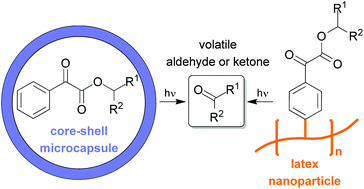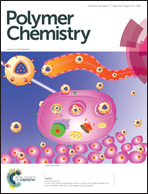“Old” chemistry in a new context: photocleavable 2-oxoacetate-containing latex dispersions and core–shell microcapsules for the controlled release of volatile compounds†
Abstract
Natural daylight is suitable for controlling the release of volatile compounds, such as fragrances, from different surfaces. Upon UVA irradiation, 2-oxoacetates (α-ketoesters) fragment in a Norrish type II reaction to form aldehydes and ketones. To profit from the stabilising effect of polymers in an aqueous environment, we extended our previous work on 2-oxoacetate profragrances to two alternative polymeric delivery systems. We thus compared the light-induced release of fragrance aldehydes from 2-oxo-2-phenylacetates encapsulated into melamine-formaldehyde core–shell microcapsules, on the one hand, with latex nanoparticle dispersions obtained by radical (co-)polymerisation of fragrance-releasing 2-oxo-2-(4-vinylphenyl)acetate monomers, on the other hand. We could demonstrate that microcapsules prepared with a minimum amount of resin in their shell performed best, while the size of the latex nanoparticles influenced the deposition of the delivery systems from aqueous media onto the target surface. Furthermore, dynamic headspace analysis above cotton showed that both systems are alternative and reliable techniques to control the light-induced delivery of fragrances in practical applications under natural daylight conditions.


 Please wait while we load your content...
Please wait while we load your content...